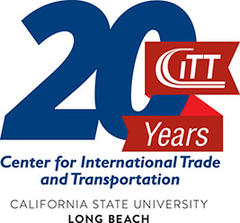There’s an old adage that “there’s always two sides to a story.” The truth is that there are as many sides to a story as there are participants. Supply chain thinking embodies that simple truth and holds the key to thriving in the 21st century economy.
Consider the following scenario: Shipping containers are lifted off megaships by gantry cranes and loaded onto trucks and trains that carry goods to warehouses where cargo is unloaded and shipped to store shelves and residences. Moving goods around the globe and throughout domestic markets requires careful collaboration among stakeholders across the entire supply chain.

Only two decades ago, the logistical arrangements for those shipments were largely coordinated via fax machines, phone calls, clipboards, and handshakes. On the consumer end of things, in-person shopping was still the preferred mode of shopping. Back then, if you said “Amazon” most people thought of a river.
Utter “Amazon” two decades later and most people think of an e-commerce multinational corporate monolith that can ship virtually anything you want to your house or business. It is widely known that Amazon is testing unmanned drone parcel deliveries. What is most amazing about this notion is that most of the American public has accepted this future reality and is not surprised by the prospect of flying robots one day replacing delivery drivers.
When it comes to the future of trade and transportation, even the most cautious subject matter experts are acknowledging that new technologies and attitudes are spurring transportation revolutions in every transportation mode: personal vehicle, mass transit, active transportation, and freight. In the personal vehicle sector, companies like Qualcomm and Intel – who made semiconductors and processors for the supercomputers that drove the internet, e-commerce, and smart phone revolutions – are now investing billions of dollars into the development of self-driving vehicles, A.K.A.: super computers on wheels. Other Silicon Valley giants like Google, Apple, Lyft and Uber are investing heavily in the vehicle-to-vehicle, vehicle-to-infrastructure, and smart-city technologies that will enable those driverless vehicles.
In the sustainable technology sector, it is worth noting that electric vehicle manufacturer Tesla recently exceeded Ford Motor Company in market value. On April 3, 2017, the New York Times reported that in addition to exceeding Ford’s “value for the first time,” Tesla had also “moved within striking distance of General Motors, starkly illustrating the growing gap in investors’ optimism over its future versus the prospects for the traditional carmakers from Detroit.”
Meanwhile, in the active transportation sector, bicycles are driving considerable change in urban centers. Over the last decade, bike sharing depots have become ubiquitous in most American cities. Also on the technological horizon are a host of new high-speed rail, crowd-sourced busing, zero-emission, and Hyperloop technologies that could create new opportunities for publically and privately funded mass transit options.
There are too many transformational changes afoot in transportation to list in this article, but one thing is certain: new transportation systems will increasingly transform the way business and communities function. At the same time, the finite amount of space available to move people and goods will become more constrained and congested. This means the viability of future transportation systems will be determined by how effective stakeholders across all modes are in synchronizing their efforts. To get to that point, leaders in transportation must understand the earlier mentioned truth about supply-chain thinking: that every stakeholder’s viewpoint is important and must be addressed. When leaders in industry, government, labor and academia think in silos they ignore the realities of their ever-evolving socioeconomic environments.
If transportation planners fail to thoughtfully mitigate freight-passenger conflicts on city streets, bicycle and commuter vehicle collisions could increase. If leaders in government and industry do not address the huge increases in packaging materials associated with e-commerce deliveries, municipal recycling and waste management systems will be overwhelmed. The logical alternative to this siloed reality is a systems approach that factors in the perspective of every stakeholder in the trade ecosystem to collaborate in a way that mitigates risk, negotiates stakeholder differences, and ultimately responds more nimbly to changing market conditions.
Twenty years ago, the Center for International Trade and Transportation (CITT) was established to convene stakeholders across the supply chain via educational programs, research initiatives, and public events to address goods movement challenges in a collaborative rather than siloed manner. During those two decades, the modern goods movement industry emerged and it became clear to CITT leadership that the best way to solve supply-chain problems was to use supply-chain thinking. That insight informed the development of CITT’s Global Logistics Specialist certification, which engaged industry experts to train the next generation of professionals. Similarly, CITT leadership used supply-chain thinking to conduct research and community engagement efforts that enlisted stakeholder participation from throughout the goods movement community.
In short, what is clearer than ever as CITT celebrates its 20-year anniversary is not a milestone on a calendar but rather a two-decade affirmation that supply chain-thinking will determine the success of not only goods movement professionals in the future but also leaders in labor, government, and academia.
(Tyler Reeb, Ph.D., is the director of research at the Center for International Trade and Transportation. He can be reached at tyler.reeb@csulb.edu.)
